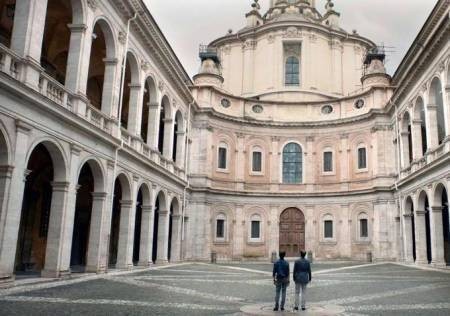-
Eugène Green: LA SAPIENZA (2014)
EUGÈNE GREEN: LA SAPIENZA (2014)

LUDOVICO SUCCIO AND FABRIZIO RONGIONE IN LA SAPIENZA
Green's beautiful but stilted Italian travelogue about couples and architecture is weighed down by its lugubrious dialogue
An American who has adopted France as his country, Eugène Green (the accent grave evidently part of his acclimatization) is an accolyte of the venerable Portuguese auteur Manoel de Oliveira; he's even gone so far as to shoot a film (his 2009 The Portuguese Nun) on Oliveira's home turf. La Sapienza, which has a lot about space, light, and baroque architecture, particularly that of Francesco Borromini, has plenty to offer if you're looking for handsome photography of seventeenth-century Italian buildings. But the people, simpering sourpusses who stare at the camera and slowly mouth lugubrious inanities at each other, have considerably less to offer. Green also owes debts to Rivette and Resnais, and this film could be taken as a variation on Resnais's Last Year at Marienbad -- only one where instead of remembered trysts at a haunting chateau, the focus is on couples therapy for a Swiss architect and his wife, which comes about through meeting young Italian siblings near Lago Maggiore, where Alexandre (Fabrizio Rongione) and Aliénor (Christelle Prot Landman) go so Alexandre can study the aforesaid Borromini.
The couple meets 19-year-old Goffredo (Ludovico Succio), coincidentally himself an aspiring architecture student, as he's holding up his sister Lavinia (Arianna Nastro), who's just collapsed from one of her periodic fits of weakness. Aliénor befriends Lavinia and has daily chats with her in French while the girl recuperates, and Alexandre takes Goffredo for a day or two on an architectural study trip to Turin. Goffredo winds up being Alexandre's teacher, explaining to him that architecture is all about space and light. And light has something to do with love: it sounds like Green has dipped into Dante's Paradiso. Reference is also made to the idea of "sapienza," which in theology is an attribute of God that manifests itself in the creation and governing of the world. The name also refers to one of Borromini's masterpieces, the Church of Sant’Ivo alla Sapienza in Rome.
The film offers hints throughout about how architecture might be better integrated with society and readapted for humane use. When Eliénor is by herself one evening a ruddy-faced man with long gray hair (Green himself) appears on a bench speaking French with an odd accent (and the same lugubrious tongue in slo-mo of everyone else) with a monologue about how he is a Chaldean from Iraq who speaks Aramaic and whose people and culture are disappearing. At the beginning and end of the film in its only music an a capella choir sings some lovely baroque compositions. The promise to reveal mysteries behind the couple's failed marriage is fulfilled, and it's hinted that the hitherto symbiotic Goffredo and Lavinia will fare better apart. In an Italian essay online Roberta Scorranese explains that this process refers to an idea of Nietzsche's about how one must not remain too attached to another person, even whom one loves. Obviously the intellectual underpinnings of Green's new film are elaborate. It's too bad the film itself is so stilted, slow, and irritating. Despite the architectural travelogue Green overwhelmingly tells rather than shows; he often seems outright to be delivering a lecture. Despite its stylistic homages to those masters, La Sapienzal lacks the elegance of Resnais and Rivette, or Oliveira's ability to bemuse and enchant. One can apply to this new film what Jay Weissberg said of The Portuguese Nun in Variety: it "uses a distended artificiality likely to produce far more giggles than intended."
La Sapienza, 100 mins., debuted at Locarno 9 August 2014, and is also included at Rio, Toronto, Vancouver, and London, represented at Toronto by Kino Lorber. It was screened for this review as part of the 52nd New York Film Festival.
Last edited by Chris Knipp; 08-28-2017 at 05:27 PM.
 Posting Permissions
Posting Permissions
- You may not post new threads
- You may not post replies
- You may not post attachments
- You may not edit your posts
-
Forum Rules





 Reply With Quote
Reply With Quote
Bookmarks